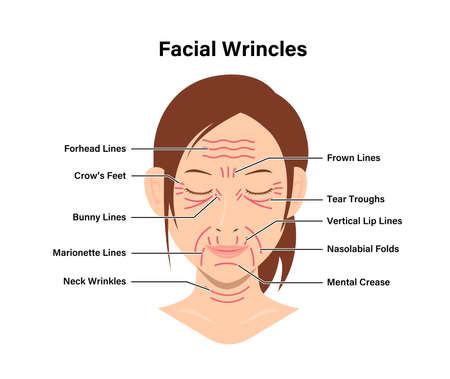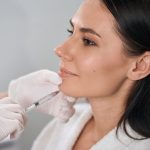1. Understanding Facial Contouring with Injectables
Facial contouring with injectables is a non-surgical way to enhance your facial structure, providing a more balanced and youthful appearance. Unlike surgical procedures, injectable treatments offer minimal downtime and natural-looking results.
How Injectables Work
Injectables work by adding volume, reducing wrinkles, or relaxing specific muscles to create a more sculpted look. Depending on the treatment area and desired outcome, different types of injectables are used:
| Type of Injectable | Function |
|---|---|
| Dermal Fillers (e.g., Hyaluronic Acid) | Add volume, smooth lines, and enhance facial contours |
| Neurotoxins (e.g., Botox) | Relax muscles to reduce wrinkles and refine facial shape |
| Collagen Stimulators (e.g., Sculptra) | Boost collagen production for long-term skin rejuvenation |
Common Treatment Areas
Injectables can be used in various areas to enhance facial harmony. Some of the most popular treatment areas include:
- Cheeks: Adding volume to lift and define cheekbones.
- Jawline: Creating a more structured and contoured jawline.
- Lips: Enhancing shape, volume, and symmetry.
- Chin: Improving projection and balancing facial proportions.
- Nose: Non-surgical nose reshaping for minor adjustments.
Benefits of Injectables Over Surgery
Many people choose injectables over surgical options because they provide effective results without the need for invasive procedures. Here are some key benefits:
- Minimal Downtime: Most treatments require little to no recovery time.
- Non-Permanent: Results can be adjusted or reversed if needed.
- Gradual Enhancements: Allows for subtle improvements over time.
- Lower Cost: Generally more affordable than surgical alternatives.
If youre looking for a way to refine your facial features without committing to surgery, injectables offer a flexible and effective solution tailored to your unique needs.
2. Types of Injectables for Facial Contouring
Facial contouring injectables come in different types, each designed to address specific concerns such as volume loss, wrinkles, and skin laxity. Understanding the differences can help you choose the right treatment for your aesthetic goals.
Dermal Fillers
Dermal fillers are one of the most popular options for facial contouring. They help restore lost volume, enhance facial features, and smooth out wrinkles. Most fillers are made from hyaluronic acid (HA), a substance naturally found in the skin that attracts moisture.
Common Uses of Dermal Fillers:
- Cheek Enhancement: Adds volume to sunken cheeks for a lifted appearance.
- Lip Augmentation: Enhances lip shape and fullness.
- Jawline Definition: Creates a more structured and contoured jawline.
- Tear Trough Correction: Reduces hollows under the eyes for a refreshed look.
| Filler Type | Main Ingredient | Best For | Longevity |
|---|---|---|---|
| Juvederm | Hyaluronic Acid | Lips, Cheeks, Nasolabial Folds | 6-18 months |
| Restylane | Hyaluronic Acid | Lips, Under Eyes, Cheeks | 6-12 months |
| Sculptra | Poly-L-Lactic Acid | Chemical Collagen Stimulation (Volume Restoration) | Up to 2 years |
| Radiesse | Calcium Hydroxylapatite | Nasal Bridge, Jawline, Hands | Around 12-18 months |
Neuromodulators (Botox & Similar)
If youre looking to smooth out fine lines and wrinkles caused by facial expressions, neuromodulators like Botox are an excellent option. These injectables temporarily relax muscles to prevent wrinkle formation.
Main Uses of Neuromodulators:
- Crow’s Feet: Softens lines around the eyes.
- Brow Lift: Lifts drooping brows for a more youthful look.
- Nasal Bunny Lines: Reduces wrinkles on the nose bridge.
- Massetter Slimming:Pcreates a slimmer jawline by relaxing the masseter muscles.
Biostimulatory Injectables
This category includes products like Sculptra and Radiesse that stimulate collagen production over time. These treatments gradually improve skin texture and firmness while restoring lost volume.
Main Benefits of Biostimulatory Injectables:
- Naturally Restores Volume: Encourages collagen growth instead of just adding filler material.
- Smoother Skin Over Time:Diminishes fine lines and wrinkles gradually.
- A Long-Lasting Solution:The results can last up to two years with proper maintenance.
Selecting the right injectable depends on your specific goals—whether its lifting sagging skin, softening fine lines, or enhancing facial structure. A consultation with a skilled provider will help determine which treatment is best suited for you.

3. What to Expect During and After Treatment
A Step-by-Step Guide to the Treatment Process
If youre considering facial contouring injectables, knowing what to expect can help you feel more confident about the procedure. Heres a step-by-step guide on what happens before, during, and after treatment.
Step 1: Consultation
Your journey starts with a consultation with a qualified provider. During this appointment, youll discuss your aesthetic goals, medical history, and any concerns you may have. The provider will assess your facial structure and recommend the best injectable options for you.
Step 2: Injection Procedure
On the day of the treatment, the provider will cleanse your skin and may apply a numbing cream to minimize discomfort. Using a fine needle or cannula, they will carefully inject the filler or neuromodulator into targeted areas. The entire process typically takes 15-45 minutes, depending on the number of areas being treated.
Step 3: Immediate Aftercare
Right after the procedure, you might experience mild redness, swelling, or bruising at the injection sites. These effects are temporary and usually subside within a few days. Your provider may give you aftercare instructions to follow for optimal results.
Downtime and Recovery
The recovery process varies based on the type of injectable used and individual healing factors. Below is a general guideline:
| Treatment Type | Expected Downtime | Common Side Effects |
|---|---|---|
| Dermal Fillers | No downtime; mild swelling/bruising for 2-5 days | Swelling, bruising, tenderness |
| Botox/Dysport/Jeuveau/Xeomin | No downtime; full effects in 7-14 days | Mild redness, slight bruising |
Potential Side Effects
The most common side effects include temporary redness, swelling, or minor bruising. In rare cases, patients may experience lumps, asymmetry, or allergic reactions. Always choose an experienced injector to minimize risks.
Recovery Tips for Best Results
- Avoid touching or massaging the treated areas for at least 24 hours.
- Avoid strenuous exercise for 24-48 hours to reduce swelling.
- Avoid alcohol and blood-thinning medications for a few days to minimize bruising.
- If you experience significant pain or unusual side effects, contact your provider immediately.
4. Who Is a Good Candidate for Facial Contouring?
Facial contouring injectables can enhance facial features, restore lost volume, and create a more balanced appearance. However, they aren’t suitable for everyone. Several factors determine if someone is a good candidate for these treatments.
Ideal Candidates for Facial Contouring Injectables
Not everyone seeking facial enhancement will benefit from injectables. The best candidates typically meet the following criteria:
| Factor | Ideal Candidate Characteristics |
|---|---|
| Age | Adults in their mid-20s to 60s looking to enhance or restore facial contours. |
| Facial Structure | Individuals who want to add definition to areas like the cheeks, jawline, or chin. |
| Skin Elasticity | Those with good skin elasticity, as sagging skin may require alternative treatments. |
| Overall Health | Healthy individuals without severe allergies or medical conditions that could interfere with treatment. |
| Realistic Expectations | Candidates should have realistic goals and understand that results are temporary and require maintenance. |
Who Should Avoid Facial Contouring Injectables?
Certain individuals may not be suitable candidates for facial contouring injectables. These include:
- Pregnant or breastfeeding individuals: There is limited research on the safety of injectables during pregnancy or lactation.
- People with severe allergies: Those allergic to ingredients in dermal fillers or neurotoxins should avoid treatment.
- Individuals with active skin infections: Skin conditions like acne or infections at the injection site can increase complications.
- Those with unrealistic expectations: If someone expects drastic surgical-like results, injectables may not meet their goals.
- Candidates with excessive skin laxity: Severe sagging may require a facelift or other surgical procedures instead of fillers.
The Importance of a Professional Consultation
A consultation with a qualified injector is essential before undergoing any facial contouring treatment. A professional will assess your facial structure, skin condition, and medical history to determine if injectables are right for you. They can also recommend alternative treatments if needed.
Your Next Steps
If you believe you’re a good candidate for facial contouring injectables, schedule an appointment with a certified provider. They will guide you through the process and develop a customized plan tailored to your aesthetic goals.
5. Choosing the Right Provider for Your Treatment
Selecting the right provider for your facial contouring injectables is crucial to achieving safe and natural-looking results. With so many practitioners offering injectable treatments, knowing what to look for can help you make an informed decision. Below are key factors to consider when choosing a qualified injector.
Credentials and Certifications
Not all injectors have the same level of training or expertise. It’s essential to verify that your provider has the proper medical credentials and certifications to perform injectable treatments safely.
| Credential | Description |
|---|---|
| Board Certification | Look for providers certified by reputable boards such as the American Board of Plastic Surgery (ABPS) or the American Board of Dermatology (ABD). |
| Medical Licensure | Your injector should hold a valid medical license in your state. |
| Specialized Training | The best injectors have completed advanced training in facial anatomy and aesthetic procedures. |
Experience in Facial Contouring Injectables
The more experience a provider has, the better they understand facial structure and how different products interact with the skin. Ask about their years of experience specifically with facial contouring injectables, not just general aesthetic procedures.
Questions to Ask About Experience:
- How many years have you been performing injectable treatments?
- How often do you perform facial contouring injections?
- Do you specialize in certain types of fillers or neuromodulators?
Before-and-After Portfolio
A reputable injector should have a portfolio showcasing real patient results. Reviewing these images can give you an idea of their skill level and whether their aesthetic style aligns with your goals.
What to Look for in Before-and-After Photos:
- Diverse patient cases that match your facial structure or concerns.
- Naturally enhanced results rather than overdone appearances.
- A consistent style that aligns with your personal preferences.
Safety Considerations and Hygiene Standards
Your safety should always come first when undergoing any cosmetic procedure. Make sure your provider follows strict hygiene protocols and uses FDA-approved products.
Key Safety Factors:
- The treatment is performed in a clean, professional environment.
- Sterile techniques are used to prevent infections.
- The injector discusses potential risks and complications beforehand.
- You receive aftercare instructions tailored to your specific treatment.
Selecting the right provider ensures you achieve beautiful, natural-looking results while minimizing risks. Take your time researching potential injectors and don’t hesitate to ask questions before committing to treatment.

